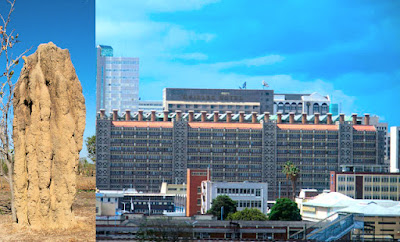Biomimicry - Why used in Architecture?
Biomimicry (from bios, meaning life, and mimesis, meaning to imitate) is a new science that studies nature's best ideas and then imitates these designs and processes to solve human problems. Studying a leaf to invent a better solar cell is an example. I think of it as "innovation inspired by nature."
The core idea is God create a nature and has already solved many of the problems we are grappling with. Animals, plants, and microbes are the consummate engineers. They have found what works, what is appropriate, and most important, what lasts here on Earth.
Like the viceroy butterfly imitating the monarch, we humans are imitating the best and brightest organisms in our habitat. We are learning, for instance, how to harness energy like a leaf, grow food like a prairie, build ceramics like an abalone, self-medicate like a chimp, compute like a cell, and run a business like a hickory forest.
Biomimics are looking to nature for specific advice: How will we grow our food? How will we harness energy? How will we make our materials? How will we keep ourselves healthy? How will we store what we learn? How will we conduct business without drawing down nature's capital?
Let's take a look at one of these categories: materials. Right now, we use what's called "heat, beat, and treat" to make materials. Kevlar, for instance, the stuff in flak jackets, is our premier, high-tech material. Nothing stronger or tougher. But how do we make it? We pour petroleum-derived molecules into a pressurized vat of concentrated sulfuric acid, and boil it at several hundred degrees Fahrenheit. We then subject it to high pressures to force the fibers into alignment as we draw them out. The energy input is extreme and the toxic byproducts are odious.
God takes a different approach. Because an organism makes materials like bone or collagen or silk right in its own body, it doesn't make sense to "heat, beat, and treat." A spider, for instance, produces a waterproof silk that beats the pants off Kevlar for toughness and elasticity. Ounce for ounce, it's five times stronger than steel! But the spider manufactures it in water, at room temperature, using no high heats, chemicals, or pressures. Best of all, it doesn't need to drill offshore for petroleum; it takes flies and crickets at one end and produces this miracle material at the other. In a pinch, the spider can even eat part of its old web to make a new one.
Imagine what this kind of a processing strategy would do for our fiber industry! Renewable raw materials, great fibers, and negligible energy and waste. We obviously have a lot to learn from an organism.
I beleve that in our studies in architecture, we have to consider the creation around us in order to create great things.
Eastgate centre in Zimbabwe...
See also...



Comments